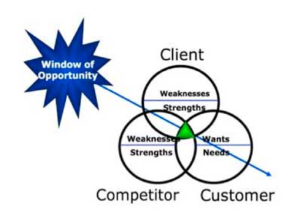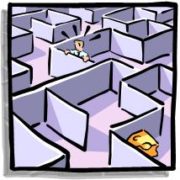Cracking the Strategic Planning Code – Ideas from the Experts
By Larry Cassidy, Marc Emmer, Diana Ho, Brian Oken, Steve Phillips & Paul David Walker
When the topic of strategic planning comes up, some individuals get very excited about the planning process while others consider it just a waste of time. With so many different styles and approaches, we thought that we’d ask a number of experts for how they approach this topic and the top three key points to think about before your next strategic planning meeting.
Larry Cassidy
Strategic Conversation
My view of so-called “strategic planning” is that today it is less an event and more an ongoing conversation. The most effective organizations are evolving, and for me that moves viable strategic thinking away from being an annual event and toward an ongoing conversation.
The idea that we can somehow nail down where and how things are (and, projected, where and how they will be into the future), and then craft a lasting response, is ineffective. The world in which we operate is constantly changing; thus, we too must participate in that same game, which requires a continuing and continuous conversation.
As that applies to crafting strategy, I recommend frequent sessions in which the “team” comes together to discuss the future. For each session, step one is to identify the most important questions which must be answered; step two is to arrive at agreement on the answers; and, step three is to define action steps based on those answers (what, why, who, how, when, resources and milestones). As you prep for these ongoing sessions, consider:
- Inviting more of, rather than less of, your management and supervisory team. Interesting ideas often come from the “less likely” participants. And participation invites a sense of “ownership.”
- Requesting from the attendees, in advance, the questions they feel are the most important to the firm’s future. You may be surprised at what you get.
- Building each session around a few key questions, using multiple breakout groups to discuss each question, and mixing people and functions within breakout groups for each topic discussion (thus creating fresh energy and different chemistry around each question).
- And, inviting a few key outsiders to participate in each session (good strategic thinkers, creative types, folks who will challenge and “stir the pot”). You will find their input tends to raise the bar for those on your team.
Marc Emmer
Strategic Planning: The Entrepreneurs Dilemma
There is one thing that almost all entrepreneurs have in common; they want to grow. Yet determining where and how to grow can prove elusive, even to the most savvy strategists.
 Often, management teams face gut wrenching strategic choices. While growing a core business incrementally offers a high probability of success, companies with a singular focus are subject to concentration risk that inhibits enterprise value. The more the company grows, the bigger the problem becomes. A diversification strategy reduces concentration, but growth far afield from one’s core competency, increases the probability of failure.
Often, management teams face gut wrenching strategic choices. While growing a core business incrementally offers a high probability of success, companies with a singular focus are subject to concentration risk that inhibits enterprise value. The more the company grows, the bigger the problem becomes. A diversification strategy reduces concentration, but growth far afield from one’s core competency, increases the probability of failure.
Often, entrepreneurial companies also lack the talent to focus on transformational business model innovations that could drive competitive advantage. Unfortunately, many companies create a 12 month forecast within their core business, and pass it off as a strategic plan. A well thought out vision balances the short term and the long term and clarifies the company’s value proposition and strategic priorities.
Here are some success factors to consider before engaging in strategic planning:
- Market Analysis-A thoughtful review of trends in the industry that will impact future demand.
- A level of preparedness on the part of the participants so that they are in a position to make fact-based strategic decisions.
- A process that enables execution on strategic objectives.
As we approach the time of year when many companies formalize their business strategies, it is important to structure a framework that ensures that management takes the time to think, both about the core business and potential disruption. Great companies weave strategic thinking into their management DNA and then convert strategies into actionable measurable tactics that drive results.
Diana Ho
The Art of Strategic Planning
Strategic planning has fallen in and out of favor numerous times since my earliest days as a planning facilitator. While my experience base and process toolbox has grown over the years, so has my “beginners mind.” Rather than bringing a methodology that works for all, I approach each planning engagement as a blank slate, pay attention, listen deeply and design each process based upon the unique characteristics of the client organization.
Every organization has a strategic plan whether they know it or not. The opportunities embedded in a “strategic planning process” include a) making the plan explicit, b) aligning expectations, c) leveraging resources and d) building a skilled planning- and accountability-minded team. The process of planning is equally as important, if not MORE important, than the resulting “plan;” and the effectiveness of any planning process is directly correlated to the extent that it is aligned with the leadership/power structure of the organization. So design the process well, Grasshopper!
When considering external resources, decide where your needs lie along the continuum of “expert” (who will tell you what your process and strategy ought to be) and “facilitator” (who will leverage your organizational resources, ask questions, provide options, build capacity and hold your feet to the fire).
Three things to consider before having a strategic planning meeting:
- What is the organizational “appetite” for planning; should we be thinking in terms of a “planning meeting” or a “planning process and mindset?”
- Who needs to be at the table?
- What are the organizational and personal rewards and consequences for planning or not planning?
Brian Oken
Strategic Planning for the Rest of Us
If you’re like most of us, you’re leading a small to medium-sized business with limited resources, no time and a million things you need to get done. To get the best results, I believe you should narrow your focus, engage your team and make your efforts count.
But before you proceed with any group planning activities, you should:
- Be clear about what you want for your business. Do you want to grow market share, sell in the near future, build a legacy…?
- Have a competent management team in place.
- Decide whether you’re going to use an outside facilitator or Do-It-Yourself.
Here’s my approach to strategic planning:
Be focused and realistic. It’s impossible for any group to successfully accomplish more than 1 or 2 strategic goals a year because of all the associated projects and tasks. If you  try to do too many things at once, it will dilute your focus and compromise your results. Remember, you want to actually achieve these goals.
try to do too many things at once, it will dilute your focus and compromise your results. Remember, you want to actually achieve these goals.
Generating great financial results is a team effort. Your plan and strategy (and the reasons for them) must be presented in such a way that everyone in your company can easily understand them. The plan must also connect daily activities to company goals. This is the only way your employees will feel connected to your overall vision. People need feedback and need to know their efforts are making a difference. Be transparent about your results and celebrate your successes!
Implementing a strategic plan is a methodical approach and an ongoing process to help you and your team work smarter and get better results. But in order for this to happen, your plan must drive the agenda of your staff meetings and be referenced and updated on a regular basis. Once you see how an effective plan can help you achieve your goals, I doubt you will ever operate without one again.
Steve Phillips
The Strategic Planning Meeting – Turbo charge your approach!
Strategic planning is by its nature, time consuming and hard! Assessing the environment and the company and then positioning and aligning resources takes tons of effort. So much effort that many Fortune 500 companies just don’t do a good job. And… it’s these companies that rarely hit their potential. But true strategic planning, (like what McKinsey or BCG does) can easily cost $1M or more. So what is the answer? How does a company do great planning at a small fraction of the cost? I think a turbo charged approach meets most everyone’s needs. It’s quick, uses your best people, gets everyone bought in to the implementation of the plan, builds-in an accountability system, and gets it mostly right. Think of it as a leveraged approach.
So what is the process for a turbo charged approach? It’s easy! I find it most useful to use a third party (not the CEO) to organize the process, collect and analyze the data, set the objectives and outcomes for the meeting (with the CEO) design the agenda, and to facilitate the meeting. In this way, people can do their work and the third party can do all the leg work. Then when it’s most important, everyone can meet and use their time together wisely.
So how to approach turbo charged strategic planning?
- Pick a third party to organize and drive the process. It can be a senior level consultant (like me 🙂 ) or an internal specialist but it should not be the CEO or President. They have much better things to do than the leg work that it will take to make the meeting effective.
- Collect valid data. Some folks like to collect both external data and internal data but some are fine with just picking the brains of their top folks on what we really need to do next to be most successful. (Remember, this is a leveraged “turbo charged” approach). I suggest the third party personally interview participants for about 60 minutes each. This should be plenty of time to assess what should be done next year.
- Create a specific and detailed agenda based upon what you learned from your data analysis. This should also include the specific outcomes and objectives for the
 meeting and detailed agenda items. Too many times people just put topics on the agenda without ever fully considering: the type of item, the champion of the item, the outcome of the item, the process for the item, the time line for the item, the pre-work needed to be ready to efficiently use time, etc. Creating a great agenda is an art and time consuming. There are many considerations and it often takes much longer than anyone expects but when done right, huge amounts get accomplished in the meeting seamlessly and the group actually enjoys the process (and if I have my way, walk out of the room a more effective team. See #5).
meeting and detailed agenda items. Too many times people just put topics on the agenda without ever fully considering: the type of item, the champion of the item, the outcome of the item, the process for the item, the time line for the item, the pre-work needed to be ready to efficiently use time, etc. Creating a great agenda is an art and time consuming. There are many considerations and it often takes much longer than anyone expects but when done right, huge amounts get accomplished in the meeting seamlessly and the group actually enjoys the process (and if I have my way, walk out of the room a more effective team. See #5). - Use a professional facilitator for the meeting. I am not just saying this because I am one. I am saying it because it works a thousand times better than not having one! I would much prefer to be maximizing everyone’s time and using each person’s brain in the room rather than have one of those folks worrying about lunch, the air conditioning or making sure the conversation stays on point. A pro will pay for themselves a hundred times over.
- Use the strategic planning meeting to tune up your team. There is no question that teams outperform groups of individuals on complex tasks about 99% of the time. It used to be that we did “teambuilding”. Now I find the best way to build your team is while they are working on a real project. A professional will know how to do this seamlessly and effectively and at the same time you are setting up your plans for the future. It’s a win win win win. Better strategy, alignment, direction, and teamwork!
- Do quarterly follow-ups to create a built-in accountability system, adjust the plan as needed, speed up the team, and continue to develop toward high performance. It only takes about 4 hours for the quarterly meeting to meet its objectives but most groups try to leverage or maximize their precious little time together. High performing teams will rotate who is in charge of each meeting and give them total freedom to run the session where and when and how they see fit. They can be at client sites, hotels, new offices, wherever will work for the theme of the day. Most groups put in place a ¾ day or all day quarterly meeting and use the extra time to develop everyone, either with team building, leadership development, site tours, or expert panels or guest speakers. It is a day everyone looks forward to. And then once a year, usually 4th Q, we do a longer retreat to close the year formally and kick off the next, all in alignment with the executive committee and shareholders meetings.
So there you have it. A leveraged approach to your strategic planning. Pick a third party to run the process, collect and analyze data, create a specific and detailed agenda, hire a professional facilitator to run the meeting, and create a built-in accountability system that ensures people stay on track and in alignment. This process works like crazy, takes very little time, is not terribly expensive, uses your people where they are best and does not waste their time. It creates ownership and buy-in, decreases resistance and makes full implementation almost assured, creates strategic alignment, builds your team and helps them to achieve and stay at high performance. It gives you a full opportunity to participate as a leader, makes everyone smarter and leaves your organization aligned, agile, collaborative, and highly productive.
Paul David Walker
Understand Present Reality
There are flows of intelligence that manifest as multidimensional streams of cause and effect at every level of life. These flows have momentum and move forward with or without you. In business these flows are formed by market wants and needs. As you consider your business strategy, it is important to understand these flows and position your  company to use these flows, like a surfer at the sweet spot of a wave, to move forward accurately. It is pointless to try to swim against the current. As you ride these flows forward you will be able to see opportunities as they emerge before your competitors. The objective is to find emerging trends that lead to a window of opportunity, as we do with our clients illustrated here.
company to use these flows, like a surfer at the sweet spot of a wave, to move forward accurately. It is pointless to try to swim against the current. As you ride these flows forward you will be able to see opportunities as they emerge before your competitors. The objective is to find emerging trends that lead to a window of opportunity, as we do with our clients illustrated here.
The Right Plan For You
It is dangerous to develop a strategic plan that does not take into account your companies true capabilities. If a surfer chooses a wave that is too big for their skills they will be drowned or seriously hurt, the same is true of a company. It does not serve well to develop a business strategy that requires more resources, talent, or momentum than the company can realistically achieve. Find a place in the flow of your market that acerbates you, not one that will drown you and your company. Once you succeed and gain power and skill, develop a bigger plan.
Explosive Targeted Actions
After understanding your place in market trends, build a simple focused strategic plan. Then eliminate all activities that do not support that plan. Make sure every executive understands that this is not a drill. It is a road map for all actions. Paint a compelling picture of the outcomes at every stage in your plan and develop the courage to act. Teams with clear missions, a sense of urgency, the stillness of a master, and explosive targeted actions are the ones that will win in the 21st century. Those that hesitate will lose. To summarize:
- Understand present reality

- Develop the right plan for you, not a grandiose fantasy
- Commit to explosive targeted actions
Permission is needed from Lighthouse Consulting Services, LLC to reproduce any portion provided in this article. © 2014
Larry Cassidy has been a Group Chair with Vistage International (formerly TEC International) for over 27 years. He currently works monthly with more than 50 Southern California executives, in three chief executive groups and one group of key executives, regarding all aspects of their businesses. Larry can be reached at hndicapper@gmail.com and 714-460-3090.
Marc Emmer is President of Optimize Inc. a management consulting firm specializing in strategic planning. Marc is the author of Intended Consequences, Design the Future you Wish to Create. Marc can be reached at marc@optimizeinc.net or at 661-296-2568.
Diana L. Ho is a seasoned facilitator/executive coach, percussionist, book-binder and kick-ass project manager. She began her career in retail merchandising and was Vice President and division head in a Los Angeles management consulting firm before founding Management Arts in 1995. Contact her at DianaHo@ManagementArts.com or 310-475-6563.
Brian Oken has a 20 year track record as a successful President/CEO, having effectively guided organizations through aggressive revenue growth to sustained profitability. Throughout his career, he has been involved in managing, operating and strategically positioning companies in the public and private/family sectors. He is well known for improving the profitability of organizations while also creating great places to work. Prior to opening his own firm, Brian spent two decades running manufacturing and service based businesses as President and CEO. His accomplishments include significantly growing income and cash, being listed on the Inc. 500/5000 fastest growing company list, engaging in international strategic alliances and the launching of numerous successful new products. CEOs, Presidents and business owners call on Brian as a trusted advisor to help grow their companies, make better decisions with greater returns and create the highest performing workplace cultures. Brian can be reached at boken@informalcowboy.com or 310-466-2804.
Steven Phillips, Ph.D., Founder and CEO. In his relentless effort to deliver uncommon results, Dr. Steven L. Phillips has built an enviable reputation for his senior team consulting service that focuses on results-driven off-sites for senior leadership, strategic planning, and executive leadership. Dr. Phillips has helped thousands of individuals and organizations establish new levels of teamwork, transformation, and performance, all specifically targeted toward bottom-line results. Dr. Phillips has extensive experience as an Organization Development professional. For many years he served as a SVP Chief Talent Officer for a privately held 1B company with 10,000 employees. As a consultant, he has worked with Senior Executives at Microsoft, PepsiCo, Viacom, Mattel, Boeing, and many others, helping individuals, teams, and entire organizations successfully implement change. Steve also works one-on-one with Presidents and CEOs helping them strategize for powerful and successful leadership. Additionally, Dr. Phillips creates customized team development activities for executive teams designed specifically to shorten cycle time to high performance. Dr. Phillips’ best-selling books are used in corporations throughout the world. His latest book, The Senior Leadership Off-site Playbook, is soon to be released. Steven can be reached at sphillips@phillipsassociates.net or 310-456-3532.
Paul David Walker, Founder & CEO of Genius Stone Partners was part of building the first leadership firm to align Strategy, Structure and Culture, and has been a business leadership adviser to the CEO’s of Fortune 500 and midsize companies for over 25 years. He is the author of Unleashing Genius: Leading Yourself, Teams and Corporations, two other books, and will publish a new book called Invent Your Future. He has succeeded by unleashing the genius of the people around him and is known to be a visionary leader and master of collaboration. Paul can be reached at pauldavidwalker@geniusstone.com or 562-233-7861.
Inspiration and Techniques for Building Championship-Level Performance
Lighthouse clients have one thing in common – all are committed to boosting the performance of their organizations. So, we are pleased to introduce our clients and friends to Boaz Rauchwerger — speaker, trainer, author and consultant. We highly recommend Boaz to you. Ask him to deliver one of his inspirational programs at your next executive retreat or strategic planning session.
One of our favorite Boaz programs is “Playing Like a Championship Team Every Day”. It helps you build on the strengths of everyone’s individual differences. This program helps you discover five steps to get everyone to join the building crew and resign from the wrecking crew. This is a very powerful and inspirational program that receives rave reviews every time.
• Master five techniques to inspire others to perform like champions
• Six recognition techniques including the powerful “good finder” program
• Learn four ways that your team can gain a competitive advantage
• Identify the three prerequisites for maximizing the team’s results
• Learn the two forms of keeping a daily score so everyone wins
Who is Boaz?
Over a 30-year span, Boaz, author of The Tiberias Transformation – How To Change Your Life In Less Than 8 Minutes A Day, has conducted thousands of seminars internationally on goal setting and high achievement. He has taught over half a million people how to supercharge their lives, their careers and how to add Power to their goals. His innovative program, for individuals and corporations, is a simple and highly effective process for high achievement. He was voted Speaker of the Year by Vistage, an international organization of CEOs and business owners. How to contact Boaz – Want more information on Boaz’s Power Program, including “Playing Like a Championship Team Every Day”? Just click here and we’ll be in touch.
If you would like additional information on this topic or others, please contact your Human Resources department or Lighthouse Consulting Services LLC, 3130 Wilshire Blvd., Suite 550, Santa Monica, CA 90403, (310) 453-6556, dana@lighthouseconsulting.com & our website: www.lighthouseconsulting.com.
Lighthouse Consulting Services, LLC provides a variety of services, including in-depth work style assessments for new hires & staff development, team building, interpersonal & communication training, career guidance & transition, conflict management, 360s, workshops, and executive & employee coaching. Other areas of expertise: Executive on boarding for success, leadership training for the 21st century, exploring global options for expanding your business, sales and customer service training and operational productivity improvement.
To order the books, Cracking the Personality Code and Cracking the Business Code please go to www.lighthouseconsulting.com.








